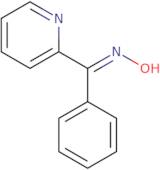Phenyl 2-pyridyl ketoxime
CAS : 1826-28-4
Ref. 3D-BAA82628
| 1g | Arrêté | ||
| 5g | Arrêté | ||
| 10g | Arrêté | ||
| 25g | Arrêté | ||
| 50g | Arrêté | ||
| 100g | Arrêté | ||
| 100mg | Arrêté |
Informations sur le produit
- (2E)-2-[nitroso(phenyl)methylidene]-1,2-dihydropyridine
- (2Z)-2-[nitroso(phenyl)methylidene]-1,2-dihydropyridine
- (Z)-N-hydroxy-1-phenyl-1-(pyridin-2-yl)methanimine
- 2-Benzoylpyridiine ketoxime
- 2-Benzoylpyridine ketoxime
- 2-Benzoylpyridine oxime
- 2-[Nitroso(Phenyl)Methylidene]-1,2-Dihydropyridine
- Ketone, phenyl 2-pyridyl, oxime
- Methanone, phenyl-2-pyridinyl-, oxime
- NSC 53389
- Voir d'autres synonymes
- Phenyl 2-pyridyl ketone oxime
- Phenyl(2-pyridinyl)methanone oxime
- Phenyl2-pyridylketoxime, (2-Benzoylpyridineketoxime)
Phenyl 2-pyridyl ketoxime (PPK) is a coordination complex that binds to the factor receptor on hl-60 cells. It has been shown to inhibit the proliferation of hl-60 cells, which is mediated by PPK's ability to bind to the growth factor and coordinate with it. The molecular structure of PPK consists of a pyridine ring and two phenyl rings connected through oxygen atoms. This molecule has four nitrogen atoms, one hydrogen atom, and one hydroxyl group. The binding constants for PPK are high, indicating that it has a strong affinity for its receptor.
PPK was crystallized in space group P2(1)2(1)2(1). Its crystal structure was determined using X-ray crystallography and was found to be tetranuclear with each metal atom occupying a different coordination sphere.





